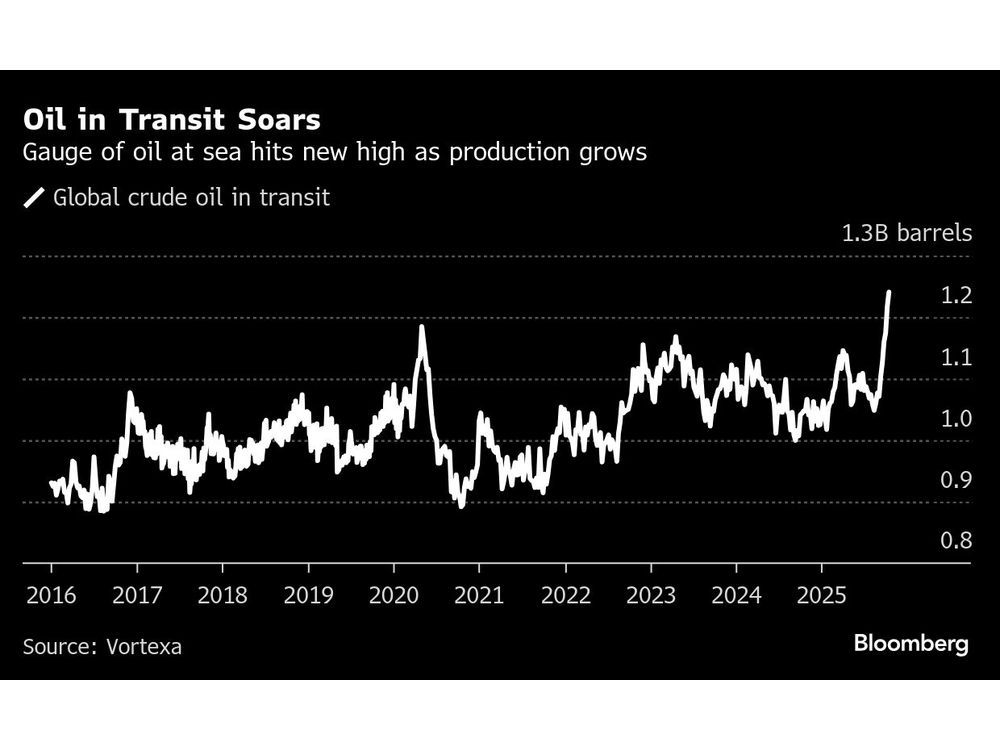Business
Crude Oil Shipments Surge to Record Levels Amid Supply Increases

The volume of crude oil transported across global waters has reached a new peak, driven by heightened production levels and extended shipping durations. As of the week ending October 17, 2023, approximately 1.24 billion barrels of crude and condensate were in transit on tankers, according to data from the analytics firm Vortexa. This figure marks an increase from a revised total of 1.22 billion barrels the previous week.
The ongoing rise in crude shipments is largely attributed to the relaxation of output cuts by members of the OPEC+ coalition, alongside increased production from nations outside the group. Notably, Guyana has recently commenced production from a new offshore field, contributing to the surge. Simultaneously, U.S. crude output has reached new highs, exceeding 13.63 million barrels per day, as reported by the Energy Information Administration.
Impact of Extended Shipping Routes
The escalation in crude oil shipments comes at a time when global demand is experiencing a slowdown. Analysts forecast that a surplus could emerge, potentially climbing to 4 million barrels per day in the early months of 2024. In the last six months, eight members of OPEC+ have collectively raised their production target by nearly 2.5 million barrels per day, although actual production increases have lagged behind these targets. The most significant contributions to this rise have been from Saudi Arabia, the United Arab Emirates, and Russia, whose combined output has grown by 1.77 million barrels per day.
Most of the crude oil is being transported to buyers in Asia, particularly China. The journey from the Middle East typically takes around a month, while shipments from Russia can take up to twice as long, according to vessel-tracking data compiled by Bloomberg. In September, OPEC+ output increased by 630,000 barrels per day, marking the highest month-on-month growth in four years, according to secondary source data published by OPEC.
New Developments in International Oil Trade
In addition to the rising volumes from OPEC+ countries, Guyana has recently made strides in its oil production capabilities. The nation shipped its inaugural cargo of the new Golden Arrowhead grade at the end of August, with production soon expected to stabilize at a plateau of 250,000 barrels per day. The first supertanker carrying Guyanese crude to China is currently en route, a significant development as this marks the first shipment to the Asian nation since May.
The increased shipping distances also contribute to the longer durations vessels spend at sea, further raising the total amount of oil in transit. For context, the journey to China is projected to take over six-and-a-half weeks, significantly longer than the route to Rotterdam, which is Guyana’s primary European destination. Additionally, two Indian refiners have purchased shipments of Guyana’s crude, marking the first such transactions since at least November 2021, when Bloomberg began tracking these flows.
As the global oil market adjusts to these changes in supply dynamics, the implications for both prices and availability on the international stage will continue to unfold in the coming months. The increase in oil shipments, coupled with a predicted surplus, suggests a complex landscape for traders and consumers alike as 2024 approaches.
-

 Science3 months ago
Science3 months agoToyoake City Proposes Daily Two-Hour Smartphone Use Limit
-

 Health4 months ago
Health4 months agoB.C. Review Reveals Urgent Need for Rare-Disease Drug Reforms
-

 Top Stories4 months ago
Top Stories4 months agoPedestrian Fatally Injured in Esquimalt Collision on August 14
-

 Technology3 months ago
Technology3 months agoDark Adventure Game “Bye Sweet Carole” Set for October Release
-

 World3 months ago
World3 months agoJimmy Lai’s Defense Challenges Charges Under National Security Law
-

 Lifestyle4 months ago
Lifestyle4 months agoVictoria’s Pop-Up Shop Shines Light on B.C.’s Wolf Cull
-

 Technology3 months ago
Technology3 months agoKonami Revives Iconic Metal Gear Solid Delta Ahead of Release
-

 Technology3 months ago
Technology3 months agoApple Expands Self-Service Repair Program to Canada
-

 Technology3 months ago
Technology3 months agoSnapmaker U1 Color 3D Printer Redefines Speed and Sustainability
-

 Technology3 months ago
Technology3 months agoAION Folding Knife: Redefining EDC Design with Premium Materials
-

 Technology4 months ago
Technology4 months agoSolve Today’s Wordle Challenge: Hints and Answer for August 19
-

 Business4 months ago
Business4 months agoGordon Murray Automotive Unveils S1 LM and Le Mans GTR at Monterey









